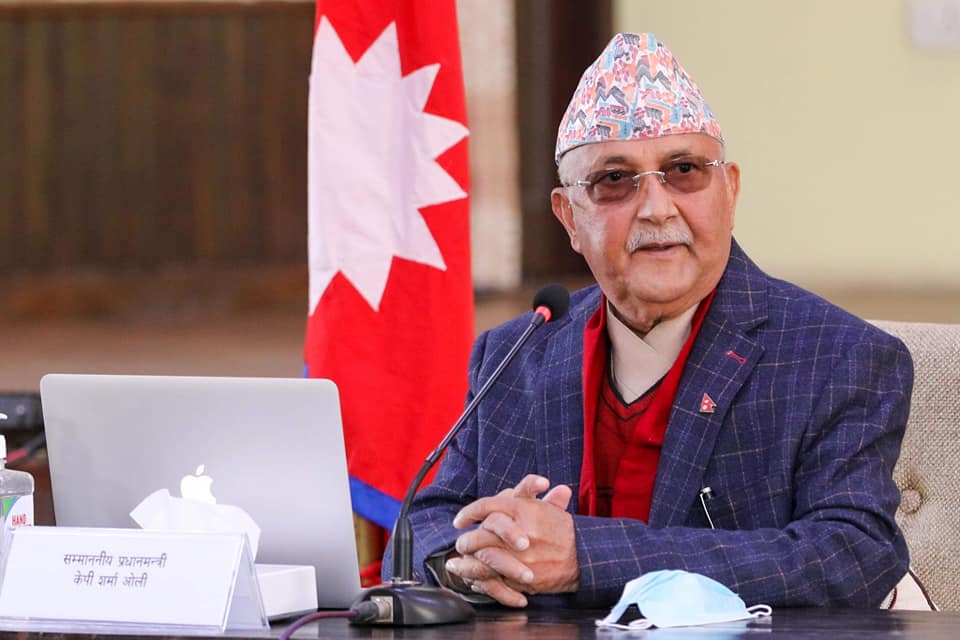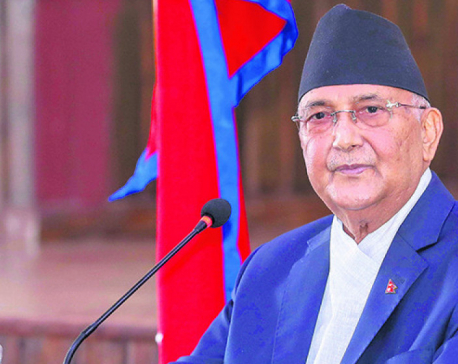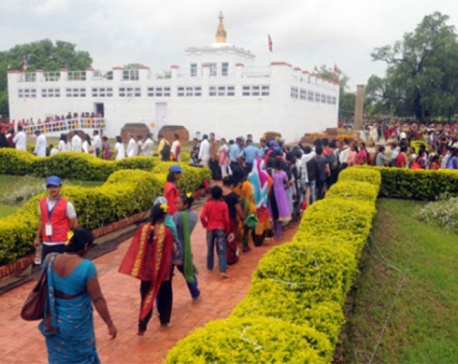
OR

There is a thin line separating creative provocation from group defamation. All too often we see TV shows or cartoons stir up discord for their libelous content or politicians and celebrities from the majority community open their mouths and emit a torrent of snobbish and racist prejudice.
Recently, two cartoons were widely circulated on social media. The first depicted PM K P Oli attired like a king with a crown on his head while holding President Bidya Bhandari in his breast pocket suggesting the president acting like a pawn at Oli's beck and call and being complicit in all of his unconstitutional moves. Oli publicly expressed displeasure against this depiction of being compared to a ghost institution that is monarchy and placing the president, a symbol of republic in the pocket of such a feudal institution.
To those familiar with Oli's penchant for playing loud and obnoxious bully to the hilt, his expression of displeasure may seem confounding and paradoxical. I see it as poetic justice. Oli has in the past taken cruel digs at intellectuals and minorities. He has not spared even his party members. For instance, he publicly tried mimicking Madhav Nepal while criticising him for going against the party diktat. He has threatened intellectuals with dire consequences and made insensitive remarks against Madhesis.
So far as his displeasure against being compared to monarchy is concerned, Oli has on more than one occasion tried to imitate practices that were typical of monarchy. After the dissolution of the House of Representative on December 20, his faction of NCP planned a mass gathering in a bid to show his strength and the venue chosen was Durbar Marg, in front of the former palace of the monarchs. Many saw this as loaded with symbolism and reminiscent of the Panchayat era when such mass meetings were organized to inform the people about the progress made by the country. His former colleagues from now NCP (Maoist Center) have accused him of reneging on the constitutional principles of federalism, secularism and republicanism and following in the footsteps of the former monarchs. Talking about the president's complicity in Oli's unconstitutional and undemocratic move is like repeating the cliché.
Such offence-taking by Oli is a privatized, subjective and arbitrary response to a feeling of hurt by an individual. He is basically insisting on respect inflation that he believes people of his stature automatically deserve. If this is legitimized as a justification for curbing freedom of expression, then it is like taking it to its logical conclusion – giving everyone a right to exercise a veto simply by pronouncing the words ' I am offended ' .
As a seasoned politician, Oli should know well that political cartoons are a way of talking truth to power while indulging in creative provocation. By ridiculing the excesses of elites, cartoonists can hold leaders accountable while challenging them to question themselves and provoke empathy for others.
The second cartoon portrayed Mahantha Thakur as a bumbling old man struggling to speak Nepali and in doing so blurted out a confused mishmash of Hindi and Nepali. The exact line in the cartoon was "Arre o bhai, hami sirf chai piyeko chu ha" , referring to his late night tea meeting with Oli. The image was, to put it bluntly, racial stereotyping of Madhesis, commonly found in the pahade-dominated media. While Thakur himself never uttered a word, a small section of people expressed disgust on social media.
By refraining from reacting against such racial stereotyping, Thakur clearly conveyed that those who are truly demeaned are not the targets of such abuse but their abusers. He set a better example as a role model compared to our thin-skinned PM. He chose to keep his sense of humor intact and proved that the most inspiring examples of dignity come not from a secure, dominant majority but from among the downtrodden who refuse to get down and dirty. More than four decades of public life in a society that is defined by conflict and controversy has trained him in the art of tolerance and steeled him for its vicissitudes.
Crossing lines
There is a thin line separating creative provocation from group defamation. All too often we see TV shows or cartoons stir up discord for their libelous content or politicians and celebrities from the majority community open their mouths and emit a torrent of snobbish and racist prejudice. In Thakur's case, too, the cartoonist is surely conscious of his capacity to cause distress and ratchet up prejudice. Then we see offended identity activists lapping on it with vengeance and playing victim to the hilt. Sometimes, politicians mobilize constituencies translating real and simulated indignation into publicity and votes and then the perception of human difference is conveniently brushed inside the carpet where they fester like rotting banana skins. Then we wait for another bout of such controversy.
The question is what then, should we do to break this cycle? First, there must be presumption in any decent society in favor of the interpretation given by vulnerable minorities as to the humiliating nature of gestures directed at them. The victim should be heard because they know the best. The counterpoint to this is if the victims are entitled only to talk about their own experience or that of their group, any wider conversation becomes impossible. This risks encouraging the subjective identity-based veto. The better alternative is to habituate to live with a somewhat higher level of offence and most valuably, keep our sense of humor intact. Theoretically, it sounds good. But haven’t we seen Madhesis being subjected to violence because of this negative stereotyping? For yours truly, who has been an eye-witness of the violent suppression of Madhes Movement 3, it will be an exercise in amnesia not to remember that Nepal police, while firing tear gas and bullets at the hapless people of Rajbiraj also shouted "Modi ko chhoro" at them in a spiteful way. If we relate this to how the media painted the Madhesi Morcha as Indian agents, state-sponsored violence seems to be the direct result of such negative stereotyping.
Second and more radical view is to enact hate speech laws to protect vulnerable minorities. We must agree here that law and free speech are antithetical to each other and may come into action only at the contested frontiers of speech. The state should better use its expressive functions rather than the coercive ones. Politicians should set an example in the way they talk about minorities of all kinds. But, in reality, far fewer politicians are ready to go against the prejudices of their voters on a regular basis.
Lastly, rather than wallowing in benign platitudes and hoping that social harmony can be achieved merely by proclaiming it, it is the responsibility of the state authorities to create enabling circumstances that facilitate open and enlightened public discourse. While tackling sensitive subjects such as race and culture, it is important that young people are equipped to think critically about prejudices they may well have inherited from their parents. The school curriculum should be designed in a way that is rich in terms of human and cultural difference with the aim of generating imaginative sympathy for each other. It is easier to change younger minds in a direct encounter with the authority of a teacher than to change more settled older ones. "There is always hope", writes John Stuart Mills, "when people are forced to listen to both sides; it is when they attend to only one that errors harden into prejudice…"
You May Like This

No, Mr Prime Minister!
KP Oli’s tendencies are wholly and growingly anti-democratic. He seems to hold no conception that an MP’s power to vote... Read More...

Reforming Planning Commission
Development planning is a political process. National Planning Commission, as part of that machinery, belongs in the Prime Minister’s Office Read More...

PM Oli, Prez Bhandari and VP Pun extend best wishes on Buddha Jayanti
KATHMANDU April 30: Prime Minister KP Sharma Oli has said that Gautam Buddha remains a symbol of pride for all... Read More...






Just In
- Challenges Confronting the New Coalition
- NRB introduces cautiously flexible measures to address ongoing slowdown in various economic sectors
- Forced Covid-19 cremations: is it too late for redemption?
- NRB to provide collateral-free loans to foreign employment seekers
- NEB to publish Grade 12 results next week
- Body handover begins; Relatives remain dissatisfied with insurance, compensation amount
- NC defers its plan to join Koshi govt
- NRB to review microfinance loan interest rate












Leave A Comment